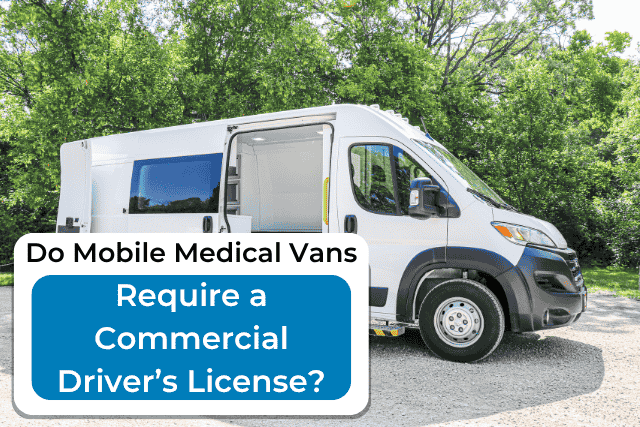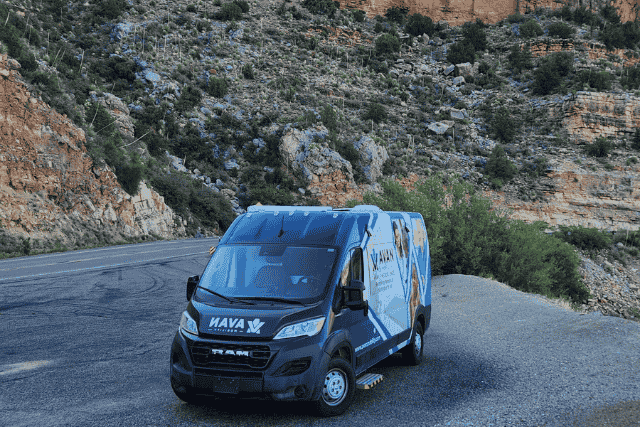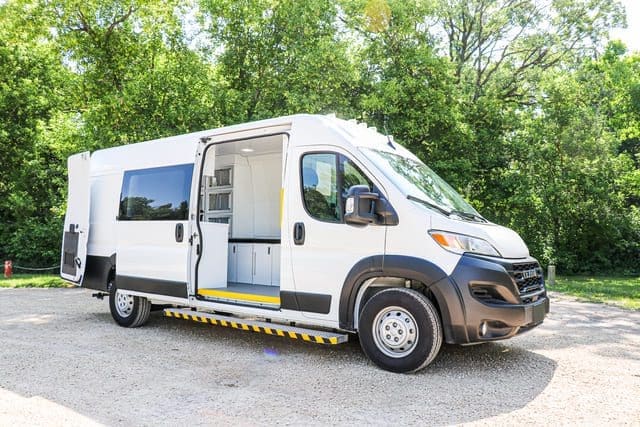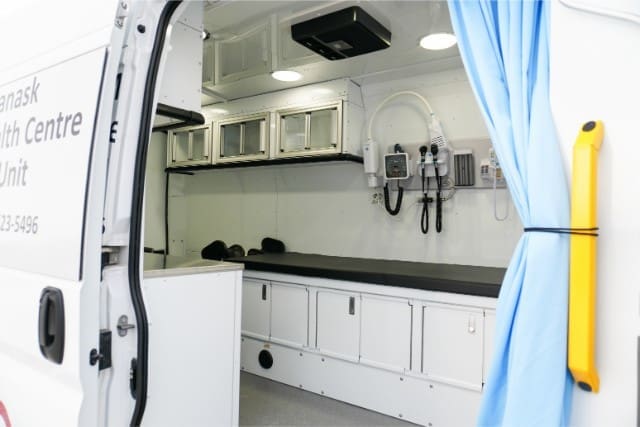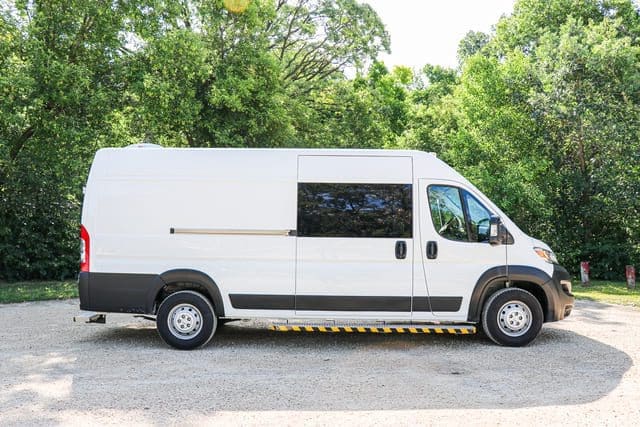No, mobile medical vans do not require a commercial driver’s license (CDL).
But if you’re here, chances are you’re wondering if driving a mobile medical unit comes with extra red tape. The last thing you want is to invest in a vehicle that ends up being a headache to operate. And if a CDL were required, that would bring a whole set of challenges:
- Limited drivers: Only certain staff could drive the unit.
- Higher costs: CDL training isn’t cheap, and it takes time.
- Staffing issues: What if your CDL driver calls in sick?
- Hiring struggles: You’d need to find employees with the right license.
- More complications: Scheduling and logistics would be tougher.
Good news. You don’t have to deal with any of that. With a mobile medical van, anyone with a standard driver’s license can operate it. That means lower costs, more flexibility, and one less hurdle to bringing healthcare to those who need it.
At AVAN Mobility, we’ve spent over 10 years designing mobile medical vans that remove barriers to healthcare. We’ve worked with organizations like yours and the Community Clinic of Southwest Missouri all across the country to create real solutions.
In this article, we’ll cover everything you need to know about commercial driver’s licenses and mobile medical units, including:
- Why mobile medical vans don’t require a CDL
- The rules around vehicle size and weight
What’s a commercial driver’s license?
A commercial driver’s license is a special license for driving larger vehicles like semi-trucks, RVs, and buses. It’s not the same as a regular driver’s license because it’s meant for people who operate heavier or more complex vehicles.
So, how big does a vehicle have to be to require a CDL?
Here’s the breakdown:
Over 26,000 pounds: If a vehicle’s gross vehicle weight rating (GVWR) is over 26,000 pounds, the driver must have a CDL.
Towing more than 10,000 pounds: A CDL is required if a vehicle is towing a trailer that weighs more than 10,000 pounds.
Passenger vehicles: A CDL is required if a vehicle is designed to carry 16 or more people, including the driver.
How do you get a CDL?
To get a CDL, drivers have to meet a few extra requirements, including:
Age requirement: Must be at least 18 years old for in-state driving and 21 for interstate driving.
Medical exam: A physical exam is required to make sure the driver is healthy enough to operate large vehicles safely.
Knowledge test: Drivers must pass a written test on road safety and commercial vehicle rules.
Skills test: This includes a driving test, where the driver has to prove they can handle a large vehicle properly.
Some CDLs also require special endorsements, like if the driver is transporting hazardous materials or driving a passenger bus.
Now, you might be wondering, if CDLs are for big, heavy-duty vehicles, why don’t mobile medical vans require one? Keep reading to find out why!
Why don’t mobile medical vans require a CDL?
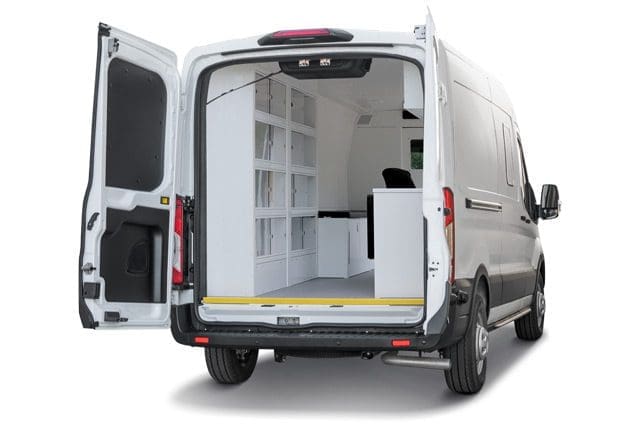
Now that you know a little more about what a commercial driver’s license is, let’s talk about why people driving mobile medical vans don’t need one.
Remember, a CDL is only needed for vehicles that:
- Weigh over 26,000 pounds
- Tow more than 10,000 pounds
- Are designed to carry 16 or more people
Mobile medical vans don’t meet any of these requirements.
Here’s why:
They weigh far less than 26,000 pounds: Mobile medical vans are well under the weight limit, meaning they don’t require a CDL. They’re built to be easy to drive, just like a large van. For example, the average weight of the Mobile Clinic Van ranges between 6,500 lbs. to 7,500 lbs.
They don’t tow heavy trailers: Mobile medical vans are self-contained, meaning they don’t need to tow extra equipment or storage units. Since they aren’t pulling a trailer over 10,000 pounds, a CDL isn’t required.
They aren’t designed to carry 16+ passengers: These vans are built for medical care, not public transportation. Even if staff and patients are inside, the total number of people is far below the CDL limit.
That means anyone with a regular driver’s license can operate a mobile medical van. No special training, no expensive certifications. You just hop in and go.
At this point, you might be curious about what types of mobile medical units require a CDL. Keep reading to find out.
What types of mobile medical units require a CDL?
Some mobile medical units are bigger and heavier, which means they do require a CDL. The key factor is weight. If the gross vehicle weight rating is over 26,000 pounds, a CDL is needed. The same goes for vehicles designed to carry 16 or more passengers or those towing trailers heavier than 10,000 pounds.
Here are the types of mobile medical units that may require a CDL:
1. Mobile medical RVs

- Weight range: Between 15,000 and 55,000 pounds, depending on size.
- Larger models (Class A RVs) often weigh over 26,000 pounds, meaning drivers need a CDL.
- Smaller Class B or C RVs usually stay under the limit, so they don’t need one.
2. Mobile medical buses

- Weight range: Often 25,000 to 40,000 pounds, depending on the build.
- If it’s under 26,000 pounds, no CDL is needed.
- If designed to transport 16 or more people, a CDL is required regardless of weight.
3. Mobile medical trailers
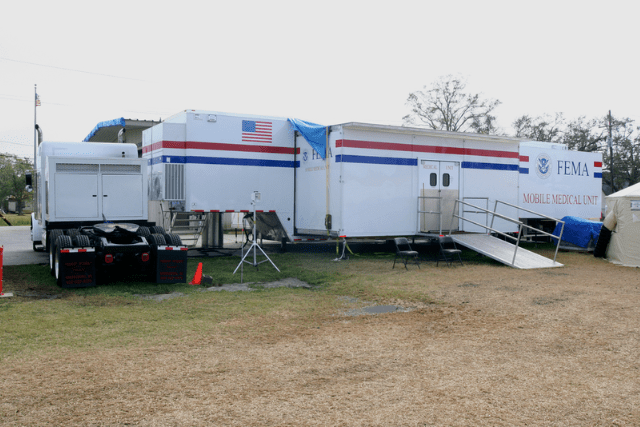
- If the trailer weighs more than 10,000 pounds and the combined weight of the vehicle and trailer is more than 26,000 pounds, a CDL is required.
- Many mobile medical trailers are light enough to avoid a CDL, but it depends on the setup.
What are the challenges of requiring a CDL for mobile medical units?
If you’re interested in a bigger mobile medical unit that requires a CDL, it can sometimes make things more complicated.
Here’s why:
Driver shortages: Only staff with a CDL can drive. If they call in sick, patient appointments may have to be canceled if no other staff have a CDL.
High training costs: A CDL costs between $3,000 and $12,000 and takes between three and seven weeks to obtain. Not everyone in your organization will be willing to undergo the training process.
Hiring struggles: Finding employees with a CDL limits your options, making it harder to fill positions.
Less flexibility: With fewer CDL-certified drivers, scheduling gets tricky, especially in emergencies.
Higher insurance costs: CDL-required vehicles usually come with more expensive insurance policies.
For many organizations, it often makes choosing a mobile medical unit that doesn’t require a CDL a more reasonable choice.
Learn more about mobile medical vans
You came here wondering if mobile medical vans require a CDL, unsure whether your team would need extra training, certifications, or special drivers to operate one. The last thing you want is to invest in a vehicle that creates more roadblocks instead of solving healthcare access challenges.
After reading this, you now know:
- Mobile medical vans do not require a CDL because they weigh less than 26,000 pounds, don’t tow heavy trailers, and are not designed to carry 16+ passengers.
- Some larger mobile medical units—like RVs, buses, and trailers—do require a CDL based on weight, towing capacity, or passenger count.
- Requiring a CDL can create challenges, such as staffing shortages, training costs, and operational delays.
At AVAN Mobility, we understand that choosing the right vehicle is about making sure your team can focus on patient care, not specifications or driver certifications. That’s why we create solutions that keep your services running smoothly, giving you more flexibility, lower costs, and fewer operational headaches.
If you have questions about finding the right mobile medical unit for your needs, click the button below to talk to a mobility expert.
Not ready to chat yet? Check out some of our other resources to keep learning.
Start by checking out our article on mobile medical van customization. This will give you a closer look at some of your vehicle’s options.
After that, check out the video below on the cost range you can expect to pay for your mobile medical van.
FAQs: Mobile medical units and CDL requirements
Q: Do all mobile medical units require a commercial driver’s license?
A: No, most mobile medical vans don’t require a CDL because they weigh under 26,000 pounds, don’t tow heavy trailers, and aren’t designed to carry 16 or more passengers.
Q: Which types of mobile medical units require a CDL?
A: Larger mobile medical RVs, buses, and trailers may require a CDL if they exceed 26,000 pounds, tow over 10,000 pounds, or are designed to carry 16+ passengers.
Q: What happens if our mobile medical unit does require a CDL?
A: You’ll need to have CDL-certified drivers on staff, which can increase hiring challenges, training costs, and scheduling limitations if a CDL driver is unavailable.
Q: How can we avoid needing a CDL for our mobile medical unit?
A: Choosing a smaller, CDL-exempt van ensures that anyone with a standard driver’s license can operate it, making it easier to staff and manage.
Q: Where can we get help choosing the right mobile medical unit for our needs?
A: Our team at AVAN Mobility has over 10 years of experience helping organizations find the right vehicle for their services. Click the button below to talk to a mobility expert!
